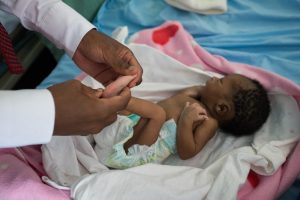
A baby at the Kangaroo mother care unit during a check up, Bungoma Kenya. Kangaroo Mother Care is part of the GSK funded Health Signature Programme being implemented in Bungoma County. Save the Children has been supporting the Ministry of Health (MoH) to establish KMC services in Bungoma County since 2014. KMC is now being implemented in 9 health facilities. Save the Children has conducted minor renovations of rooms provided by the county Ministry of Health (MoH) for KMC, provided basic equipment for care of the babies, trained health care workers and established follow-up mechanisms of babies discharged to continue with KMC at home. The County on the other hand has been responsible for ensuring that the KMC units are adequately staffed with sufficient medicine and commodities for care of the babies as well and food and linen for the mothers while they are admitted. 95 health care workers have been trained on KMC and this includes health managers. The project also trained community level service providers on KMC and these are crucial for follow up of mothers practicing KMC at home. Working with community staff has been useful in increasing acceptance and improving family support and involvement even at community level. The project has also conducted sensitization sessions on KMC to 18 KMC mothers who practised KMC and these mothers are now volunteer peer support to other mothers as KMC champions. Their main role is to conduct KMC support group meetings at facility level to encourage other mothers to use KMC and they receive technical guidance from the health care workers. Working with champions has enhanced acceptance of care of the babies through KMC both at facility and community level. The result has been a drop in the proportion of babies lost to follow up. These women have become very popular and are now trusted community resource persons on KMC.
Introduction
Community health worker (CHW) interventions are promoted to improve maternal and newborn health in low-income and middle-income countries. We reviewed the evidence on their effectiveness in reducing socioeconomic inequities in maternal and newborn health outcomes, how they achieve these effects, and contextual processes that shape these effects.
Methods
We conducted a mixed-methods systematic review of quantitative and qualitative studies published between 1996 and 2017 in Medline, Embase, Web of Science and Scopus databases. We included studies examining the effects of CHW interventions in low-income and middle-income countries on maternal and newborn health outcomes across socioeconomic groups (wealth, occupation, education, class, caste or tribe and religion). We then conducted a narrative synthesis of evidence.
Results
We identified 1919 articles, of which 22 met the inclusion criteria. CHWs facilitated four types of interventions: home visits, community-based groups, cash transfers or combinations of these. Four studies found that CHWs providing home visits or facilitating women’s groups had equitable coverage. Four others found that home visits and cash transfer interventions had inequitable coverage. Five studies reported equitable effects of CHW interventions on antenatal care, skilled birth attendance and/or essential newborn care. One study found that a CHW home visit intervention did not reduce wealth inequities in skilled birth attendance. A study of women’s groups reported greater reductions in neonatal mortality among lower compared with higher socioeconomic groups. Equity was most improved when CHWs had relevant support for assisting women to improve health practices and access health care within community contexts.
Conclusion
While current evidence remains limited, particularly for mortality, existing studies suggest that CHW interventions involving home visits, cash transfers, participatory women’s groups or multiple components can improve equity in maternal and newborn health. Future mixed-methods research should explore intervention strategies and contextual processes shaping such effects on equity to optimise these efforts.